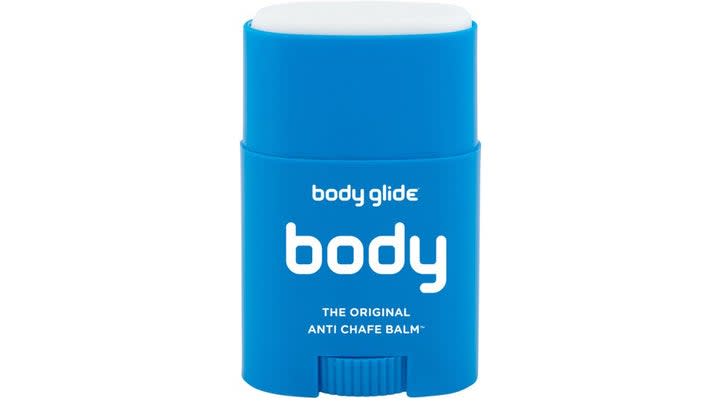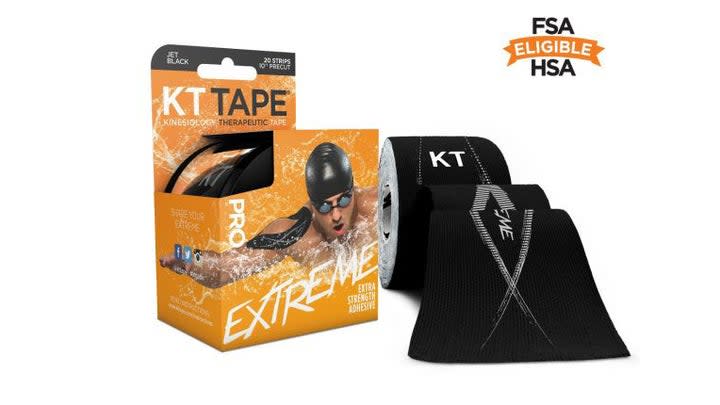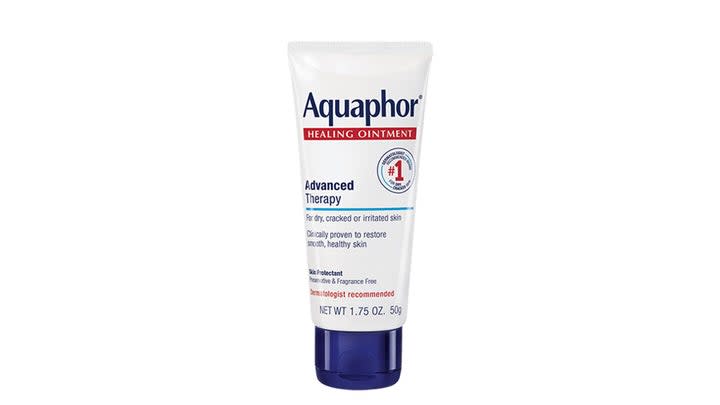Ask A Gear Guru: How Do I Prevent Chafing In The Swim?
This article originally appeared on Triathlete
If you're reading this, then you've either already done a triathlon or you're thinking about doing your first. That puts you into one of two categories: The former who has had that horrifying post-race experience where you're standing in the shower, the water hits you, and it's like someone is stabbing hot pokers at random spots on your body. Or you're in the former category, and you haven’t had to think about how to prevent chafing in the swim. Yet.
A good number of chafing misfortunes are riding related--bad cycling shorts, saddle too wide, sitting on the wrong part of the saddle, etc.--or running related--wet shoes, ill-fitting shoes, sports bra rubs, heart-rate chest strap issues. But plenty of those impossible-to-prepare-for hotspots in the shower are a result of rubbing in the water--particularly if you're racing long-course, and even more so if you're in the ocean or another salty body of water with a wetsuit. So what is a rubbed-raw person to do?
RELATED – Ask a Gear Guru: What Is the Best Cold-Water Swim Gear?
How Do I Prevent Chafing In The Swim? Anti-Chafe Balm Is Your Friend
Step one for pretty much any new triathlete, no matter how many tris you're going to do, is to buy a stick of anti-chafe balm--it should come free with every race entry. Put it all around your neck, in your armpits, on your lats and traps, between your thighs, and everywhere your race suit ends. Put it anywhere your body has folds, creases, or something folds up against a crease. Pro tip: You can even put that anti-chafe balm on the wetsuit or trisuit itself! If you know you have a gnarly seam or hem, coat it in balm.
Hands down, anti-chafe balm has the highest value-to-cost ratio of any product in triathlon--for less than $10, you are saving yourself from so much (so much) unnecessary pain in a sport that is already plenty painful enough. You should get the biggest stick of anti-chafe balm you can find, and make sure you have it with you at all times. Be sure to avoid the old petroleum jelly trick--anything petroleum-based, including some aerosols, can literally eat away at your wetsuit. Don't use PAM, don't use Vaseline, just use something made for this (our pick is below). Also: Anyone who says they’re not using anti-chafe balm is straight up lying to you. Be warned.
How Do I Prevent Chafing In The Swim? Get A Better-Fitting Wetsuit
Here, we're mostly talking about wetsuit chafing in the swim--because that's the genesis of 75% of swim-related chafe-age--so the fit of your wetsuit is super important. This is one of those purchases where you should really be trying it on in a shop or shopping somewhere online that allows you to try on a few sizes and return what doesn't fit. So many new triathletes don't like how tight the neck of a wetsuit can feel--particularly on lower-end wetsuits--but that tightness helps keep water out and can usually help prevent rubbing. Also, most neoprene stretches after being in the water for an hour or two for the first time, so you want it to be snug post-stretch. If your wetsuit takes in water, you'll be in trouble; if it's loose enough that it rubs, you'll also be in trouble.
How Do I Prevent Chafing In The Swim? Put On Your Wetsuit Right
This is another entirely avoidable dilemma, but it happens even to the best of us. Race morning is always super hectic, and zipping up is usually about the last thing you do with the least amount of attention. And yet if you don't tuck the neoprene flap under your zipper on your back or you don't fold the top flap down flat, pull it tight, and make sure any rough parts are above neoprene and not touching your skin, that momentary lapse in judgement will cost you post-race, almost guaranteed. First, be sure you have someone you trust help zip you up and fold over your velcro tab--don't trust that guy with the masochistic look in his eye and nothing but a Speedo on, he'll lead you astray every time. Second--and we'll talk about this more below--be sure to practice with your wetsuit as much as possible. You'll eventually get a feel for how the flaps and zippers and velcro should go, so even if you don't have a trustworthy companion nearby at the start, you'll be able to DIY, which is of course the name of the game right now.
How Do I Prevent Chafing In The Swim? Practice
OK, so even if you're an experienced triathlete, don't skip this section. "Of course you need to practice swimming in a wetsuit, everyone knows that." No, you really do, and maybe not for the reason you think: If you spend enough time swimming in your wetsuit--of course still using anti-chafe balm and all of the other tips above--you should be sighting far far more than you would in the pool. And it's that sighting motion of putting your head up and creating a new fold in that crease that can often cause chafing. But if you do it enough in practice a callous will often form and the skin on the back of your neck will toughen, just like your feet when you get back to running again for the first time. While the thought of a thin, rough shell on the back of your neck might not be the most attractive idea, it will also save you from pain later down the line.
How Do I Prevent Chafing In The Swim? The Nuclear Option
There's one group of multisport athletes who have more experience than anyone when it comes to wetsuit chafing--swimrunners. With many ocean events that involve a dozen swim-run transitions and sometimes over five miles of open-water swimming in incredibly challenging (and salty) conditions, swimrunners get some of the most savage chafing you'll see anywhere. And while a big part of their rubbing issues boil down to the nonstop action and transitions of their sport, a lot of it has to do with hours and and hours of sweat and salt accumulating, drying, cooking, and layering up. It's enough to make me tear up just thinking about it.
So what's a swimrunner to do? Some swimrunners use athletic tape on the back of their necks to stop chafing in its tracks. And since there's no transition area in swimrun, some will even go for the nuclear option and use super super sticky KT therapy tape to create a second skin on their necks. The only downside here is that KT tape is both difficult and often painful to take off, so it's a little bit of a value proposition. But if neck chafing is truly preventing you from having a good race experience and nothing else works, just know the nuclear option is out there.
How Do I Prevent Chafing In The Swim? Get A Better Wetsuit
Of course the gear guy is going to give this advice! But it's true--better, more high-end neoprene that you often find on higher-end wetsuits is more supple, thinner, smoother, and often has more attention paid to the neck flap area. The stitching on high-end wetsuits is often finer and usually covered with high-quality taping. Some high-end wetsuits even forego a velcro tab and use magnets (to a varying degree of success in my experience). Not only do higher-end wetsuits use better neoprene and have nicer details and binding, but they usually have more panels of fabric. More panels of fabric mean a better-fitting suit overall and less chance for wetsuit folds to get into your body's creases. While we'll give some wetsuit options below to help, buying a super-expensive wetsuit is far from the only way to reduce chafing, but it certainly helps. Read on for our gear must haves.
How Do I Prevent Chafing In The Swim? The Must-Haves
Best Anti-Chafe Balm
Body Glide
Starting at $5 for .35oz, amazon.com

Body glide is the original go-to anti-chafing balm, and there's a reason it's still around. Somewhere between a paste and a cream, this roll-on stick goes on smooth (warning: don't get sand in it) and gives as much protection as you need. Pro tip: Put it on your skin and on the fabric itself in areas you know will cause friction. The balm on your skin may rub away fairly quickly, but it'll impregnate the material too. We recommend getting the big 2.5oz. stick and having the smaller one as an emergency backup, since this is not something that's appropriate to share on race day.
Best Chafing Nuclear Option
KT Tape Pro Extreme
$22, amazon.com

First, be warned that KT tape is incredibly adhesive and is very very difficult to take off. It's also not specifically made for chafing protection, so you'll have to be very careful when you apply it. If you create a fold or crease when putting it on, you could be in an absolute universe of pain afterwards. But if nothing else will do, and you understand the implications, this version of KT Tape is made for all types of skin, no matter how oily, and will work specifically in the water. Use it at your own risk!
Best Chafing Treatment
Aquaphor Healing Ointment
Starting at $5 for 1.75oz., aquaforus.com

While some people like to use Aquaphor as an anti-chafe balm, we've found that their products are a little too thin to provide the long-lasting barrier of protection a triathlete would need. On the other hand, our editors swear by Aquaphor (and lots of it!) as a post-chafing treatment. This should go into your race-day bag, not as a preventative measure, but as something you'll almost certainly need after you take that brutal post-race shower.
Best Budget Wetsuit To Avoid Chafing
Synergy Endorphin Fullsleeve
$300, amazon.com

While we're crazy about Synergy's pricing overall, this wetsuit also checks all of the big marks to prevent chafing while swimming. First, it's available in a wide range of sizes--particularly when it comes to larger sizes for women--and if it fits better, you'll have a better chance of avoiding chafing in the first place, like we talked about above. Second, the Endorphin has what our expert reviewer Sara McLarty says is, "the most comfortable neck design and material we have tested." That's a pretty big deal.
Best High-End Wetsuit To Avoid Chafing
Ark GOAT
$575, arksports.com

Leave it to a swimrun brand to have one of the best suits when it comes to both flexibility and chafe prevention. Of all of the suits we’ve tried on--at any price range--this once feels the best around the neck, as the supple neoprene and meticulous attention to seam detail is unparalleled. If chafing is your number-one concern, you’ll have a hard time finding a wetsuit that’s close.
For exclusive access to all of our fitness, gear, adventure, and travel stories, plus discounts on trips, events, and gear, sign up for Outside+ today.

